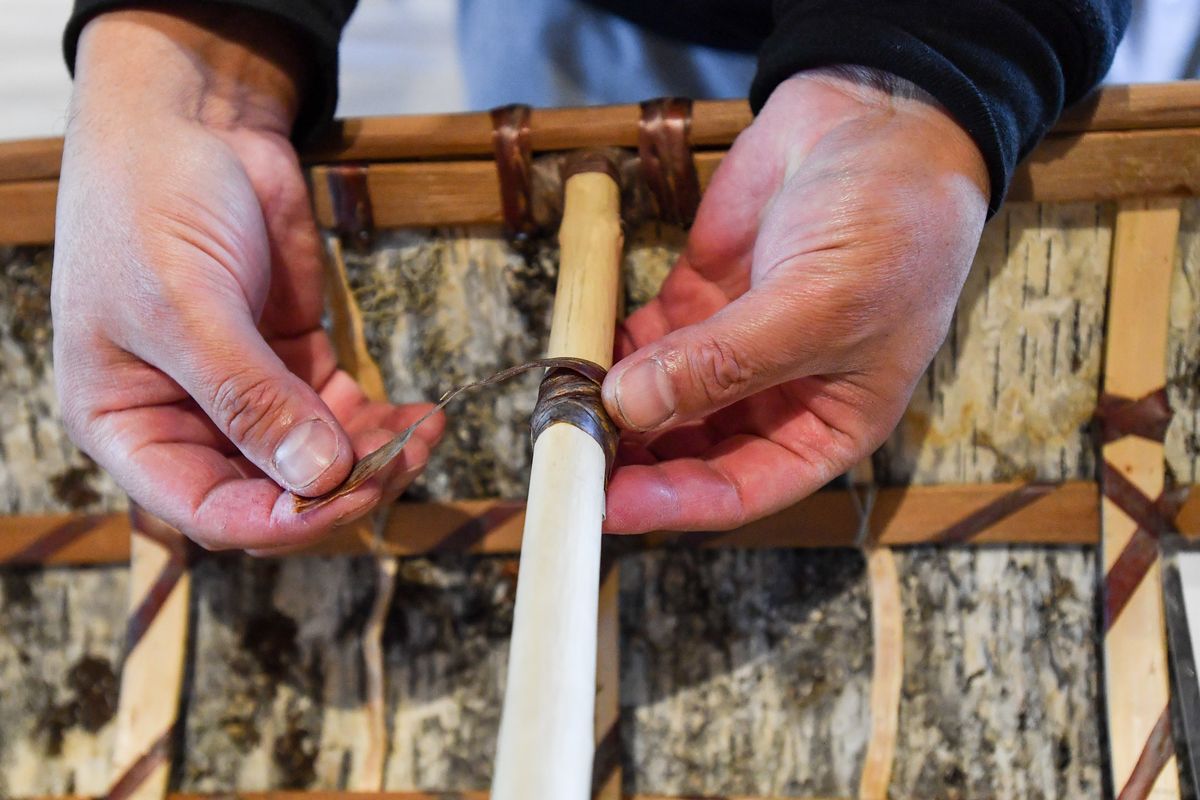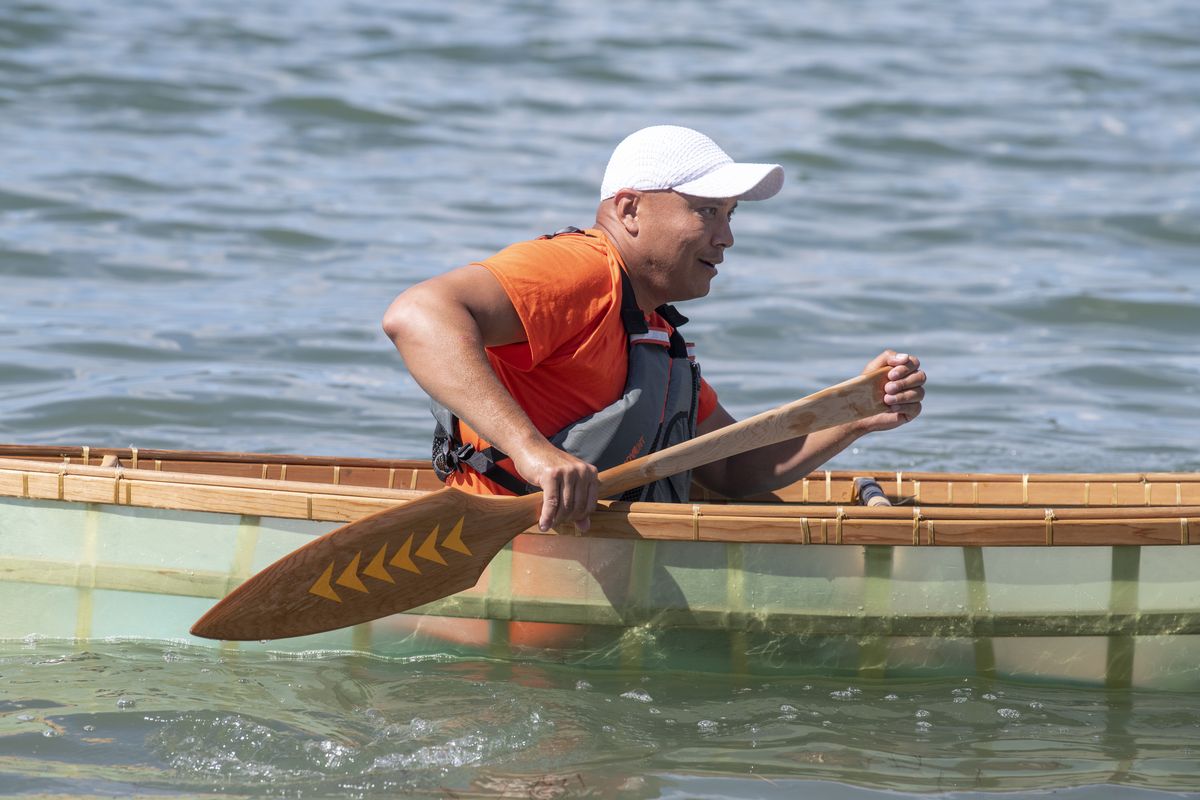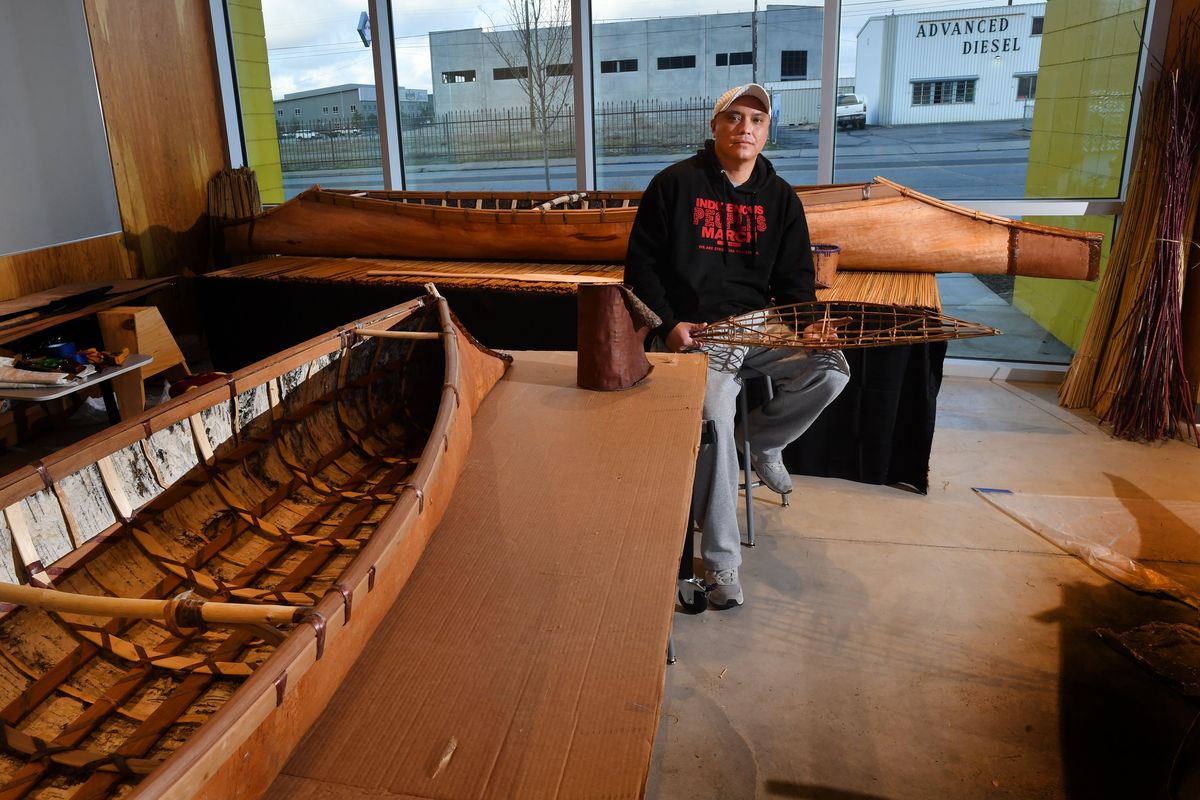‘These answers will come back to us.’ Architect and Spokane tribal member Shawn Brigman ignites a new path in recovering Indigenous canoe culture
ABOVE: Artist-in-residence Shawn Brigman poses for a photo with two ancestral sturgeon-nose canoes on Tuesday, Dec 14, 2021, at The Hive in Spokane, Wash. LEFT: A traditionally made Salishan Sturgeon Nose Canoe. The canoe is 16 feet long and weighs about 40 pounds. (Tyler Tjomsland/The Spokesman-Review)Buy a print of this photo
For many artists, the art-making process is spiritual. One must mentally and firmly grasp onto sparks of creativity and deliver it into the physical with care and precision, a meticulous intentionality. Some ideas blossom quickly and take decades. For other people, like architect and artist Shawn Brigman, creating art is an early, swift concept.
“When I was 4, 5 years old, I found my sumesh, which is our spiritual power. It is something that happened (early) and that’s what’s been guiding me the whole time.”
Now, at 47, Brigman has spent most of his life spearheading the innovation of Salishan sturgeon-nose canoes. Brigman, a member of the Spokane Tribe, has turned the revival of canoe making into his passion, but with the real goal of recovering this part of his Indigenous culture.
“The reason I do all this is to show everyone, Native and non-Native people, that this is a culture that is alive and being lived out today in 2021,” he said. “I’ve been called a Renaissance man, but I like those descriptions and I see myself as someone pushing the envelope on this cultural recovery.”
The journey as a cultural recovery artist began during his bachelor’s studies in architecture studies at Washington State University. In 2004, Brigman studied abroad in Denmark, examining Scandinavian architecture and Viking ships. While at a museum in Roskilde, a town west of Copenhagen, he was inspired how Danish people rediscovered their heritage.
“I knew right then and there what I wanted to do: I would go recover our unique and distinct sturgeon-canoe culture from the northern Plateau tribes,” Brigman said.
Before canoes, Brigman mastered tule mat lodges, small shelter houses created with the tule plant found in the rivers and marshes of North America and Canada. With these lodges, Brigman was able to better understand the labor associated with creating Indigenous items. He also realized the lodges and the canoes relied on similar frameworks.
“On that tule mat lodge, there’s a structural frame very similar to canoes. If I take this canoe and put it upside down, it’s now house architecture to keep me out of the rain and snow,” he said.
With many lakes and waterways in the region, Indigenous peoples used canoes to transport items back and forth and often gave them as gifts to the community.
“These canoes were employed for hunting, fishing, travel,” Brigman said. “It was used in a ferry system to get items from one side of the river to the other. It was documented that during a marriage, the bride -to -be would bring a canoe as a gift to the community that she’s married to.”
Brigman has created an entirely new method called a Salishan Sturgeon Nose Canoe. Instead of using western pine bark for the skin of the canoe, he uses a ballistic nylon cover, and created slight modifications to the design to accommodate the new material. One of the reasons is his own innovative nature, the other is due to climate change’s effects on the natural materials used for the original canoes.
“For the cultural recovery to happen, we just have to get out there on the landscape, waterscapes and mountainscapes,” He said. “These answers will come back to us.”
Different aspects of Brigman’s life aligned as he mastered the art of creating canoes. His educational background in architecture, the able-bodied privilege to harvest materials for eight to 10 hours, and the Indigenous communities who guided Brigman have been colorful, critical ingredients of his cultural recovery journey. Even the relationship between the human body and nature is examined.
The spacing of the ribs on his canoes is the size of his hands.
“Some dimensions are based off the base of my elbow to the top of my hand. I’m starting to notice all my work is dialed in to literally all my personal dimensions,” he said.
In 2012, back in Spokane, Brigman’s journey began with two workshops. The Lower Kootenay Band invited Brigman to a workshop to understand how to prep materials for canoes through harvesting and processing materials. The other was with Francis Cullooyah , a citizen and cultural director of the Kalispel tribe. Cullooyah’s leadership is critical as the Kalispel have specific knowledge of the ancestral bark used for sturgeon-nosed canoes.
When he was learning about making canoes, Brigman wanted to examine a bark sturgeon-nosed canoe at the Northwest Museum of Arts and Culture. Brigman said he was told by the MAC that Cullooyah would first have to approve.
“He must’ve said ‘yes’ because, two weeks later, I received a phone call from Francis inviting me out to do a western pine bark harvest.”
Brigman took a day trip around the northern tip of Idaho. Sturgeon-nosed canoe materials such as western white pine bark and bitter cherry are in abundance in North Idaho’s forests. Cullooyah invited two other elders to assist him and Brigman, deepening Brigman’s love for cultural recovery.
“There was elder and youth presence,” Brigman said. “To see tribal members working as a family unit to get that bark harvested was recreation, work and leisure all connected together. We worked as one family unit and to see that play right in front of my eyes just blew me away, very inspiring.”
After a decade in canoe-making and cultural recovery, Brigman’s work landed him as one of the four inaugural artists selected for the Hive Residency last September at the Hive, a new Spokane Public Library in the East Central neighborhood focused on arts education and events. Those who earn residencies get free use of art studios as well as opportunities to display their work at libraries.
Eva Silverstone, the arts education specialist for the Spokane Public Library, said during the selection process, she championed Indigenous artists whose work embodies the Indigenous culture as an important addition to the Hive. She described Brigman as a “quiet man who is very dedicated to his work” as his desire to inform and educate stand out during the residency.
“We got a chance to apply the pigment to one of the Salishan Sturgeon Nose Canoes and he was really good at giving us step by step on how to do it. He guided us,” she said. “The Hive is the perfect place for Brigman to spread his wings.”
The Hive also has been a space of collaboration for Brigman. The Indigenous film company Counting Coup requested Brigman make a spirit canoe for the movie “Strongest at the End of the World.” He was able to host that meeting in the Hive space.
“We mocked up that spirit canoe over there,” Brigman said, pointing to an empty corner where a few chairs were. “We talked about it like, ‘What do you want the spirit canoe to look like for this movie?’ Then we brainstormed ideas on what that could be.”
With his own space, Brigman conducts his own experiments of ethnography, the study of specific customs related to people and cultures, which has kept canoe-making and other Indigenous practices alive.
Brigman uses his Instagram (@salishansturgeonnosecanoes) and Twitter (@Cmtus_Sturgeon) accounts to showcase the process of canoe-making..
For videos, Brigman attaches one magnet to his phone case and the other to one of the metal vents in his workspace in the Hive and does a time -lapse video to showcase hours of creation into a minute video.
“I had to get better about attributions,” he said. “Where did I learn root harvest? Basket maker Bernadenne Phillips. Where did I learn white pine bark harvest? Oh, Francis Cullooyah of the Kalispel tribe.”
In a tweet from Nov. 23, Brigman shows the process of him priming the outer bark of the canoe before it dried out in a 45-second video. Throughout his media gallery, Brigman is able to go through a step-by-step process of how the canoes come to life.
Brigman can work on three canoes at a time in the Hive. With his heavy-duty truck parked outside the building, it’s easy transportation for Brigman to get canoes from his space to such consumers as museums.
For Central Washington University’s Museum of Culture & Environment, Brigman last fall created his first exhibition, showcasing the different canoes made by different tribes. The exhibition highlighted education, Brigman’s initial goal of cultural recovery.
“The museum exhibition told me, ‘Shawn, the work that you’re doing is important,’ and I need to hear that,” Brigman said. “Central Washington University giving me my first solo gallery opportunity, that was empowering to acknowledge my 10 years of canoe work. And also gave me visibility and the courage to continue on this journey.”
Hope Amason, director of the museum, believes that forging relationships with artists of color can heal the damaged relationship between Indigenous communities and museums, a long, ruffled relationship that involves museums robbing tribes of their culturally archived materials during periods of colonization. For Amason, Brigman showcases the importance of recognizing knowledge as a “shared and communal” practice.
“The reason why this knowledge is lost is because of the legacy of colonialism, and so many children were forcibly removed from their families and forced to go to boarding schools, so a lot of this knowledge wasn’t carried on, interrupting the continuity of culture,” she said. “Shawn’s here to come back and get this knowledge, but what’s cool is that it’s a wonderful experience to create a canoe like this and how we can be innovative. It’s something unique within itself.”
During Brigman’s exhibition, Amason found Brigman’s background as an architect fusing with his Indigenous canoe culture as a plus to museum visitors, especially children. Earlier this year, she watched in awe as visiting students from Morgan Middle School in Ellensburg were struck by Brigman’s “deep knowledge and level of knowledge” and how he is able to incorporate it into his craft.
“Even college students as well, I was particularly struck with young people who asked questions like ‘How would he know what kind of wood to select?’ ‘How can this particular bark act as an elastic?’ ” Amason said. “They were so excited to engage with a set of pieces that were engaged in the gallery that demonstrate an intimate knowledge of the environment.”
Brigman said preserving what he has rediscovered will be a community effort. He believes that by the time he is 55, he will begin the next chapter of his life and artistry – eldership.
Passing down his canoe technique and skills to the younger generation is pivotal. As an Indigenous man, Brigman believes it’s his responsibility to educate, a belief that circles back to his initial goal of cultural recovery.
Social media as “contemporary ethnography,” it is not enough for Brigman. With a desire for something more tangible, Brigman is setting his eyes on a writing a book that details all he learned while creating his Salishan canoes, of which he has made well over 30, as well as the ancestral bark sturgeon-nosed canoes of which he has made only five.
“There’s going to be some academic footnotes, ethnography, historical illustrations and referencing, combined with my first-person narrative,” Brigman said. “It’ll be in Chicago style where it’ll be 80% my narrative and the references will be in footnotes.
“I’m working in that direction, but because I got my Ph.D. in these hardcore academic environments, I want to bring some of that academic tone with me but also focusing on those findings, those evocative findings I have discovered over the years.”


